The brick surface is attractive in itself. But often the owners of the building are not satisfied with the color of the facade or texture. This can be fixed by painting the walls of the house. In addition, the paint protects the brick from moisture and temperature changes.
Criteria for choosing paint for a brick house
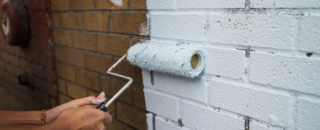
When choosing a coloring composition for the facade, an important feature should be taken into account. Brick is a porous material, even if it has an even smooth surface, it absorbs paint well. This finish is extremely difficult to remove. The choice of shade and gloss of paint must be taken seriously.
Requirements for facade coatings are more serious than for wall paints inside a building:
- Masonry mortar most often contains alkalis. Only materials resistant to alkalis are suitable for painting the facade.
- The frame must be equally waterproof to protect the walls from rain and snow, and vapor permeability. If the coloring layer prevents the removal of excess moisture from the room, condensation accumulates inside the walls, which leads to their destruction.
- The coating must be resistant to ultraviolet radiation - not fade, not dry out, not flake off.
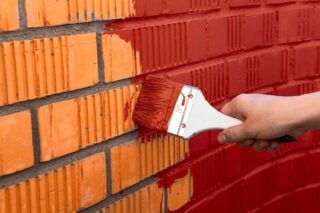
You need to take into account the technical characteristics of each material:
- Consumption - the liquid composition is consumed sparingly, but does not form a uniform layer and has a low hiding power. Medium density material is preferable: it fits better, does not stretch behind the roller.
- Adhesion is the ability to adhere to the wall material. The lack of adhesive properties of the coloring composition is compensated by a preliminary primer.
- Drying speed - special fast drying paints dry literally in a day. But in this case, the staining should take place in one layer and the last one should be applied perfectly. If the master does not have such a high qualification, it is better to take the usual composition and paint over in 2 layers.
Painting a brick house is carried out only with compounds intended for exterior decoration. By default, they differ from other paints by a higher resistance to the action of cold and heat and form a dense, durable film.
Varieties of paints
For the construction of a house and facade cladding, different building stones are used: silicate bricks, clay, hyper-pressed, clinker. Materials differ in the level of adhesion, hygroscopicity, resistance to alkalis or acids, and this factor must also be taken into account when choosing.
For painting sand-lime bricks, it is recommended to take acrylic and latex, as they form a dense waterproof film and protect the walls from moisture. For clinker, only a special paint is needed, since the adhesive properties of the ceramic stone are small, and the porosity is extremely low.
Lime
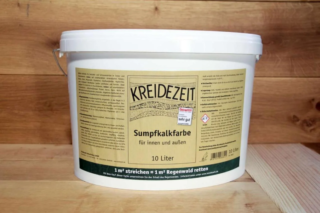
The most versatile option is a lime-based composition. It is not afraid of the action of alkalis, has properties similar to masonry mortar and has a disinfecting effect, preventing the growth of fungi.
The binder is slaked lime mixed with mineral fillers and additives. When dry, the binder carbonizes, forming a thin layer of limestone on the brick wall.
The pros are as follows:
- low cost;
- resistance to water, alkali, temperature drops;
- high vapor permeability.
The disadvantages include low mechanical strength and low hiding power. The first minus is compensated by the addition of quartz sand.
Latex
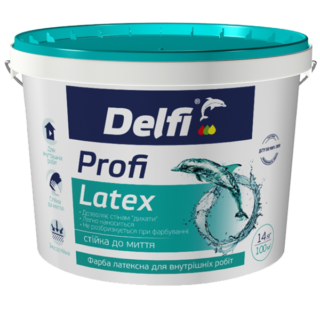
It is better to paint the brick facade with acrylic paint with the addition of latex. In this composition, polyacrylates are the base, and rubber is an additive. When dry, the components of the coating polymerize and the latex provides a more elastic and thin film.
The paint has a lot of advantages:
- low consumption without compromising the quality of the coating;
- high vapor permeability with moisture resistance;
- acrylic coating is not afraid of rain and snow, it can be washed;
- the paint is indispensable if there is already efflorescence on the facade: the composition prevents the re-formation of salt streaks.
Another plus is the possibility of tinting. This allows you to create a unique facade design.
Organosilicon

Composition based on polyorganosilicate compounds. The suspension includes coloring pigments, silicone resins, modifiers.
The main advantage is heat resistance. Home painting can be done at any time of the year at temperatures from -20 to +40 C and even during and after rain. There are other advantages:
- absolute protection against corrosion, therefore, not only stone, but also metal is painted with this composition;
- inertness in relation to most chemically active substances;
- long service life - at least 15 years;
- the coating is dielectric, so that the brick facade does not attract dust and dirt.
The disadvantages include the toxicity of organosilicon paint. When dry, toxic substances are formed, therefore the compositions are used only for outdoor decoration.
Enamel
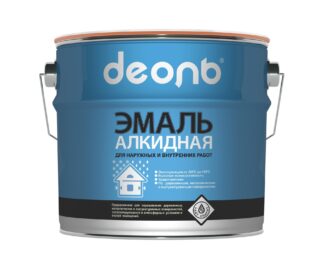
Alkyd or enamel paints are a kind of oil paints. The binder in the composition is alkyd resins, and the solvent is drying oil, kerosene and similar substances. When dry, alkyds oligomerize, forming an exceptionally waterproof durable film.
The advantages of the mixture are as follows:
- High water resistance - facades are not afraid even of salt water. Walls can be washed with water and any household products that do not contain white spirit.
- The paint protects against mold and mildew.
- The coating is mechanically strong, it is difficult to damage it.
- Enamels have a high hiding power, they mask the color and fine texture of the stone.
Disadvantages of alkyd enamels:
- High price.
- Enamel adhesion to brick is weak, so it is better to invite a professional to work.
- When dry, the solvent evaporates - kerosene or drying oil. The process is accompanied by a strong unpleasant odor and has a negative impact on health.
Alkyd enamels are also available for interior use, so before buying, you should make sure that the chosen paint belongs to the option for exterior use.
Surface preparation
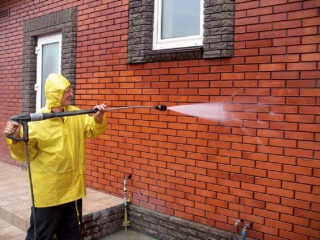
Facade painting begins with preparation. The strength and decorativeness of the future coating depends on the quality of the work.
- The walls are cleaned of mold and mildew, if any, the old coating is removed.
- Remove saline solutions with water and a wire brush.
- Get rid of dust, dirt and oil stains with soapy water and special solvents.
- If required, the seams of the masonry are renewed.
- To improve adhesion, the surface is sanded, cracks and crevices are putty.
- The facade is treated with a primer. It is recommended to select a composition that is resistant to alkalis.
At the time of painting, the walls must be dry and clean.
Features of painting a brick house with your own hands
How and what to paint a brick house outside depends on the type of brick. For clinker, a short-haired roller is suitable, for textured one - a wide, long-haired brush. With a large wall area, it is recommended to take a spray gun.
- All surfaces that cannot be painted are covered with plastic wrap or cloth.
- Dilute or prepare a coloring solution. Better to do it in small portions.
- A brush or roller is dipped into the solution, excess paint is removed from the side of the container.
- Paint is applied to the surface, moving in one direction. The composition is applied with a slight overlap with each stroke.
- The second layer is applied after the first one has completely dried. At the same time, they move in different directions to ensure uniform application.
Using a spray gun greatly simplifies the work. However, this method requires some skill.
The nuances of facade staining
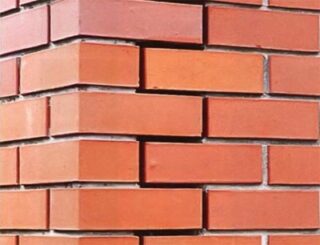
In order for the paint on a brick facade to serve for a long time, the following recommendations must be followed:
- Walls must not be painted earlier than a year after construction. Walls and foundations tend to shrink somewhat, and the stone must reach an acceptable moisture level.
- Be sure to treat the walls with antiseptic solutions, otherwise the appearance of mold cannot be avoided.
- Walkways or trestles will be required as additional inventory, since painting walls from a stool or stairs is inconvenient and dangerous.
- It is necessary to paint walls, especially with organosilicon compounds, in protective clothing. An apron, gloves, a protective mask, and sometimes a respirator are required.
- A layer of paint is applied to the entire surface at a time. If the area is large, you can take a break for a couple of hours, but no more. Otherwise, the shade in different areas will be different.
- Be sure to apply 2 layers of paint. For 1 time it is not possible to achieve uniformity of the coating.
Painting of a brick building is performed to protect the walls from moisture, salty air, snow, or to make the facade decorative. The work is simple and can be done on your own.








